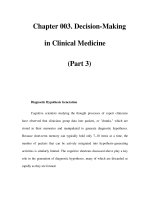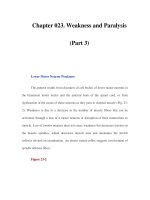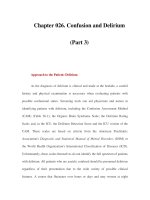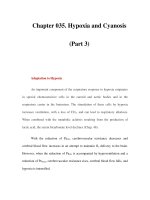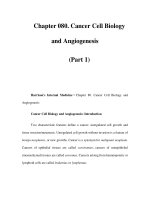Chapter 080. Cancer Cell Biology and Angiogenesis (Part 3) ppt
Bạn đang xem bản rút gọn của tài liệu. Xem và tải ngay bản đầy đủ của tài liệu tại đây (36.8 KB, 5 trang )
Chapter 080. Cancer Cell Biology
and Angiogenesis
(Part 3)
Figure 80-1
Induction of p53 by the DNA damage and oncogene checkpoints.
In response to noxious stimuli, p53 and mdm2 are phosphorylated by the
ataxia telangiectasia mutated (ATM) and related ATR serine/threonine kinases, as
well as the immediated downstream checkpoint kinases, Chk1 and Chk2. This
causes dissociation of p53 from mdm2, leading to increased p53 protein levels and
transcription of genes leading to cell cycle arrest (p21
Cip1/Waf1
) or apoptosis (e.g.,
the proapoptotic Bcl-2 family members Noxa and Puma). Inducers of p53 include
hypoxia, DNA damage (caused by ultraviolet radiation, gamma irradiation, or
chemotherapy), ribonucleotide depletion, and telomere shortening. A second
mechanism of p53 induction is activated by oncogenes such as Myc, which
promote aberrant G
1
/S transition. This pathway is regulated by a second product of
the Ink4a locus, p19
ARF
, which is encoded by an alternative reading frame of the
same stretch of DNA that codes for p16
Ink4a
. Levels of ARF are upregulated by
Myc and E2F, and ARF binds to mdm2 and rescues p53 from its inhibitory effect.
This oncogene checkpoint leads to the death or senescence (an irreversible arrest
in G1 of the cell cycle) of renegade cells that attempt to enter S phase without
appropriate physiologic signals. Senescent cells have been identified in patients
whose premalignant lesions harbor activated oncogenes, for instance, dysplastic
nevi that encode an activated form of BRAF (see below), demonstrating that
induction of senescence is a protective mechanism that operates in humans to
prevent the outgrowth of neoplastic cells.
Acquired mutation in p53 is the most common genetic alteration found in
human cancer (>50%); germline mutation in p53 is the causative genetic lesion of
the Li-Fraumeni familial cancer syndrome. In many tumors, one p53 allele on
chromosome 17p is deleted and the other is mutated. The mutations often abrogate
the DNA binding function of p53 that is required for its transcription factor
activity and tumor-suppressor functions, and also result in high intracellular levels
of p53 protein. Inactivation of the p53 pathway compromises cell cycle arrest,
attenuates apoptosis induced by DNA damage or other stimuli, and predisposes
cells to chromosome instability. This genomic instability greatly increases the
probability that p53 null cells will acquire additional mutations and become
malignant. In summary, it is likely that all human cancers have genetic alterations
that inactivate the Rb and p53 tumor-suppressor pathways.
Tumors expressing mutant p53 are more resistant to radiation therapy and
chemotherapy than tumors with wild-type p53. If the transcriptional functions of
the mutant p53 could be reestablished in tumor cells, massive apoptosis might
ensue, whereas normal cells would be protected because they express very low
levels of wild-type p53. Investigators have screened chemical libraries for
compounds that inhibit tumor cell growth in a mutant p53-dependent manner. One
compound entered cells and induced mutant p53 to adopt an active conformation
such that p53-dependent transcriptional activation was restored and apoptosis was
selectively induced. This compound also had anti-tumor activity in murine
xenograft models. Other investigators have identified a low-molecular-weight,
cell-permeable compound that inhibits the apoptotic functions of wild-type p53
found in normal host cells. This compound protected mice from the toxic effects
of radiation therapy and chemotherapy, including bone marrow suppression,
gastrointestinal dysfunction, and hair loss. Taken together, these approaches
provide proof of principle for the pharmacologic manipulation of p53 function
(mutant or wild-type) that could greatly enhance therapeutic efficacy while
decreasing toxicity.
Knowledge of the molecular events governing cell cycle regulation has led
to the development of viruses that replicate selectively in tumor cells with defined
genetic lesions. Such "oncolytic" viruses include adenoviruses designed to
replicate in tumor cells that lack functional p53 or have defects in the pRB
pathway. The former group includes an adenovirus mutant in which the viral p55
protein (which binds and inhibits p53) was deleted; this virus selectively replicates
in tumor cells lacking p53 function.
This virus has shown efficacy in phase II clinical trials of head and neck
tumors, especially when combined with 5-fluorouracil and cisplatin (50% partial
or complete response). The complexities of virus-host interactions (i.e., immune
response against replicating virus) will require further refinements of this novel
technology before the clinical utility of this approach can be fully realized.
